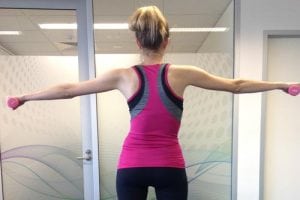When we think about scoliosis treatment we tend to focus on there here and now – normally this means concentrating on getting the correct diagnosis and making sure the right treatment program is put in place. What’s often less discussed however, are plans for going forward after you have completed your treatment. This is especially the case when bracing – we know that bracing can offer a significant reduction in cobb angle, but what happens when it’s time to stop wearing the brace?
Does the end of bracing mean the return of scoliosis?
At our clinic we often encounter clients who wonder whether the end of bracing means a reversal in the correction achieved – will scoliosis start to develop again after bracing? It’s a fair question – but thankfully research shows that a scoliosis specific exercise program – exactly the same kind of program which is usually used to support bracing – can actually be highly effective in reducing loss of correction after bracing.[1] The results of the study suggest that simply continuing with a scoliosis specific exercise program can, in fact, prevent any loss of correction.
Scoliosis specific exercises are already recommended not only as a compliment to bracing, but also as a means to avoid some of the pitfalls associated with wearing a brace – the most common issues being muscular stiffness loss of strength.[2] In fact, it’s common to use scoliosis specific exercises for a period before beginning bracing – as some research suggests this may promote a quicker correction.[3]
It’s therefore not surprising that exercises may have a valuable role to play during the weaning phase of treatment too. Brace weaning itself is a critical phase of treatment which can vary in both its nature and duration according to the patient. In some instances, clinicians reduce the daily hours of brace in a somewhat rapid way, shifting from full-time wearing (18 or more hours per day) to the point that the patient is totally free from the brace within a period of six to 12 months. Others progressively and slowly reduce the hours of brace use, with a mean reduction of two to three hours every six months.[4] Researchers currently believe that a failure to properly support and train the trunk muscles during this period may be responsible for the loss of correction which sometimes accompanies the end of treatment – however, scoliosis specific exercises can be used to address this specific problem.
What does the research say?
The results of one of the few studies on this specific issue were certainly encouraging– in the 2008 study, sixty-eight patients were monitored throughout their process of brace weaning. The patients were divided into two groups according to whether or not exercises were performed during the weaning period. The exercise group included 39 patients and was further divided into two sub-groups: a SEAS group, who performed SEAS exercise programs, and an “other” group – who performed a variety of other forms of scoliosis specific exercise. 29 patients were placed in the non- exercise group.
The study followed the patients for 2.7 years – at the end of treatment, Cobb angle had increased in the non-exercise group (by approximately 3.5 degrees) – however both the SEAS and other exercise groups saw their cobb angles remain stable – no change was detected.
So does the end of bracing mean the return of scoliosis?
In short, it certainly does not have to! From a patient’s perspective it’s important to find a clinic which also provides a solid aftercare plan however. At the UK Scoliosis clinic, we take great care to plan a course of treatment which includes appropriate brace weaning support, so that maximum correction can be maintained. As new research becomes available in this regard, we’ll apply it to our programs wherever appropriate.
[1] Fabio Zaina et al. Specific exercises performed in the period of brace weaning can avoid loss of correction in Adolescent Idiopathic Scoliosis (AIS) patients: Winner of SOSORT’s 2008 Award for Best Clinical Paper, Scoliosis 2009, 4:8
[2] Negrini S, Aulisa L, Ferraro C, Fraschini P, Masiero S, Simonazzi P, Tedeschi C, Venturin A: Italian guidelines on rehabilitation treatment of adolescents with scoliosis or other spinal
deformities. Eura Medicophys 2005, 41(2):183-201
[3] Negrini S, Negrini A, Romano M, Verzini N, Parzini S: A controlled prospective study on the efficacy of SEAS.02 exercises in preparation to bracing for idiopathic scoliosis. Stud Health Technol Inform 2006, 123:519-522.
[4] Negrini S: The Evidence-Based ISICO Approach to Spinal Deformities. 1st edition. Milan, Boston: ISICO; 2007.



